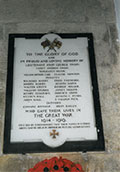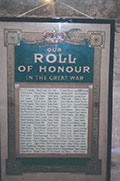Company Sergeant Major William Arthur Clee, 27384
- Batt - 9
- Unit - Royal Dublin Fusiliers
- Section -
- Date of Birth - 1890
- Died - 09/09/1916
- Age - 26
Add to this record?
If you have photographs, documents or information that can contribute to this record, you can upload here
ContributeSource: Michael Doyle Their Name Liveth For Evermore: The Great War Roll of Honour for Leicestershire and Rutland. He was the son of Albert John Clee a grocer and beer seller, born 1868 in Normacot, Staffordshire and his wife Lucy Jane Clee (nee Hibbert, married on the 29th October 1888 in St. Paul’s Church, Edensor, Staffordshire), born 1867 in Longton, Staffordshire, and who was the daughter of William Hibbert, of Spring Garden Road, Edensor. William Arthur was born in the 2nd quarter of 1890 in Fenton, Staffordshire, he had one sibling, a brother Edward, born 1870 in Normacott, also residing with the family was his maternal aunt, Mary E. Hibbert a potter’s gilder, born 1868 in Longton, in April 1891 the family home was at 53, Victoria Road, Stoke upon Trent, Staffordshire. In March 1901 William was residing in the family home at East End, Long Clawson, Leicestershire, together with his father, now an assurance agent, his mother and sister, Ethel Mary., born 1895 in Fenton. In April 1911 William was absent from the family home at East End, Long Clawson, residing there was his father, an insurance agent, his mother and sister, Ethel, a dressmaker’s apprentice, William was serving as a Private with the 12th Royal Lancers and was stationed at Potchefstroom, Transvaal, South Africa.
On Friday May 5th 1916 The Melton Mowbray Times & Vale of Belvoir Gazette published the following article under the heading. “LOCAL AND DISTRICT NEWS.” – LONG CLAWSON. – SOLDIER ON LEAVE. Coy. Sergt. Major W. A. Clee has been home on leave. He took part in the fighting on the French front last week, when the enemy, after two gas clouds, penetrated the front line trenches, under cover of smoke from smoke bombs. By a counter-attack by the Irish troops, after the gas had somewhat cleared, they re-occupied the lost trenches in less than half an hour.
The War Diary records: 9 Sept-16 – SHERWOOD and FAGAN TRENCHES. The Battalion was in the support trench which it had dug. On the morning of the 9th September the dispositions of the units of the 48th Brigade for the assault of GUINCHY which had been ordered were as follows. In front trench with orders to take the first objective and consolidate it. 7th ROYAL IRISH RIFLES. 1 section Trench Mortar Battery. 1st ROYAL MUNSTER FUSILIERS. 1 section Trench Mortar Battery. In support trench with orders to take the second objective and consolidate. 9th ROYAL DUBLIN FUSILIERS, 1 section Machine Gun Company. 1 section 156th Company ROYAL ENGINEERS. 8th ROYAL DUBLIN FUSILIERS. 1 section Machine Gun Company. 1 section 156th Company ROYAL ENGINEERS. At ZERO (4.45pm) the line advanced under the artillery barrage on the first objective, each Battalion assaulting with 4 Companies in the front line, on a frontage of one platoon, platoons at 40 yards distance. First Phase. Right Battalion (1st ROYAL MUNSTER FUSILIERS) at the outset very heavy officer casualties were suffered. The right Company experienced considerable opposition owing to the inability of the 8th ROYAL MUNSTER FUSILIERS to advance. This Company was therefore wheeled to the right and dug in. Owing to the shortage of officers the other Companies lost direction and went on beyond their objective. Left Battalion (7th ROYAL IRISH RIFLES) closely followed by the 7th ROYAL IRISH FUSILIERS reached the first objective with slight resistance and with very few casualties. Second Phase. Right Battalion (8th ROYAL DUBLIN FUSILIERS) advanced to the second objectives at 5.25pm and gained it without encountering very serious opposition. Left Battalion (9th ROYAL DUBLIN FUSILIERS) advanced to the second objective at 5.25pm but suffered very heavy officer casualties in doing so. Captain W. J. MURPHY (commanding) being killed as the Battalion reached GUINCHY. The Battalion owing to the loss of officers carried on beyond the second objective and had to be brought back and owing to the fact that the 55th Division had not come up. The left flank had consequently to be brought back slightly. The line gained was consolidated.
On Friday August 3rd 1917 The Melton Mowbray Times & Vale of Belvoir Gazette published the following article under the heading. “MELTON AND THE WAR” – LONG CLAWSON SOLDIER’S DEATH. Company Sergeant Major William Arthur Clee, Royal Dublin Fusiliers, the only son of Mr and Mrs A. J. Clee, Long Clawson, was reported missing from the 9th September, 1916, but his parents have now received the sad notification of his death from the Dublin Record Office, in the following terms:- “No further news having been received of Coy. Sergt-Major William Arthur Clee, Royal Dublin Fusiliers. The Army Council have been regretfully constrained to conclude that he is dead, and that his death took place on the 9th September 1916 (or since).” From the first there was little doubt as to his sad fate as the following letter was received from his closest friend in the battalion, Q.M. Sergt. W. Cahill, in answer to a letter from his father. (After the battle of Ginchy.) “In the Field, 17th October 1916. My Dear Mr Clee, - I received your letter of the 12th inst. I am indeed very sorry to tell you that, in my opinion, no hopes can be entertained of your son and my very good friend Billy being alive. I grieve with you very much at the loss of a very good fellow and splendid soldier. But what better death would he have wished for, than to die in a charge that will be remembered as one of the fiercest and most memorable of the war? He was seen going over the top with several of his boys, and the next and last of him that was seen was in a big shell-hole apparently badly wounded. Since then he cannot be traced, poor fellow! I expect he died with a good number of his company, and was buried by one of the thousand shells that were falling all round. He could not possibly have been taken prisoner, neither was he taken to a hospital, or we would have been informed long ago. Neither was he buried by another regiment, or they would have returned his identity disc to us, so we all (his pals) have satisfied ourselves that he has gone to his great long rest. I assure you on behalf of his Irish comrades in arms that we miss him very much. He was a good friend, and jolly fellow. His officers, too, thought a great deal of him, and, sad to say, his best friend and Company Commander was killed very shortly before him. A good number of his battalion received honours for gallantry after the event, but he and a very good number also had the greatest honour of all – “They died for their country.” I would have written to you earlier, but I did not know your address, and I thank Miss Wall for putting us in communication. Condoling with you and his relatives very much, I remain, yours very sincerely, W. Cahill.” The deceased soldier was 26 years of age and the following is a brief sketch of his career:- He enlisted in the R.F.A in 1907, and was transferred to the 12th Royal Lancers in 1909, going out to the regiment, then stationed in India, in November of that year, afterwards moving to Africa, from whence they returned home. His promotion had been quick, and soon after his return he was put on the staff at the Eastern Cavalry Depot, Woolwich, and later in Dublin, up to going out to France to join his regiment again. He transferred from the 12th Royal Lancers to the Royal Dublin Fusiliers in March, 1916, having volunteered as an N.C.O. for the infantry, and fought with them up to his death, which will be deplored by his wide circle of friends.
- Conflict - World War I
- Unit - Royal Dublin Fusiliers
- Former Unit n.o - 2150
- Former Unit - 12th Lancers
- Cause of death - KILLED IN ACTION
- Burial Commemoration - Thiepval Mem., Somme, France
- Born - Fenton, Staffordshire
- Enlisted - Nottingham
- Place of Residence - East End, Long Clawson, Leicestershire, England
- Memorial - ST. REMIGIUS'S CHURCH, LONG CLAWSON, LEICS


